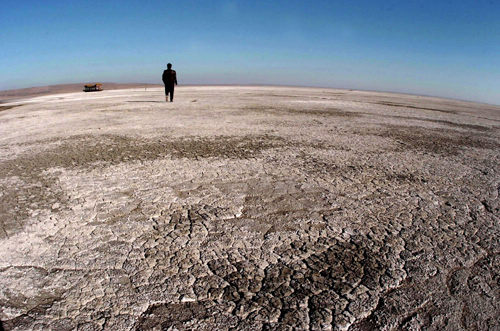|
 |
|
VANISHED LAKE: A man walks on the parched bed of Angulizhuo Lake, on December 1, 2004. The lake dried up because of a drought and overexploitation of groundwater (YANG SHIYAO) |
"Groundwater has been overextracted in more than 300 regions of China, over a total area of 190,000 square km," said Yu Qiyang, Vice Minister of the Ministry of Water Resources at a press conference on October 28. Approximately 2 percent of the country's total area is affected.
The excessive withdrawal of groundwater causes a host of problems including lowering the groundwater table and land subsidence. "Aquifers may become compressed and their capacity to hold water may diminish; in China's eastern plains, seawater may intrude contaminating both land and ground water," said Shi Jiansheng, Director of the Institute of Hydrogeology and Environmental Geology under the Chinese Academy of Geological Sciences.
Damage associated with the overuse of groundwater is now seen in many parts of China, particularly in north China.
Angulizhuo, a freshwater lake in Zhangbei County, Zhangjiakou City of Hebei Province, dried up in 2004. The parched and cracked lakebed is now exposed to the sun. Covering an area of 6,000 hectares at its height, the lake was one of the largest inland lakes in north China.
Ye Bin, a 49-year-old resident in Shibagu Village, which sits on the erstwhile lake's bank, was nostalgic about fishing in its waters. Ye started fishing there when he was in his 20s. He said that at the time the residents of the 20 villages surrounding the lake made a living primarily on fishing.
"Several meters from the bank, the water was up to my chest. In the lake's center, the water was about seven to eight meters deep," Ye said.
Local residents still puzzle over how such a huge lake disappeared in just a few years. Experts at the local hydrological department believe that dry weather and the overexploitation of groundwater were the main culprits.
A dry spell starting from 1999 set in over the region and lasted four years. Traditionally, farmers in the region mainly planted drought resistant crops such as wheat, flax and potatoes. But from 1997, the region began to promote vegetable cultivation, which consumes more water. Groundwater was drawn to irrigate vegetables, especially during the drought.
Large-scale well boring started in 1998. "In 2000, the good profits from growing vegetables motivated farmers to sink more wells," a staff member at the hydrological department of Zhangjiakou City told Hebei-based Yanzhao Evening News.
"The local government regarded well drilling as a means to alleviate poverty and improve the yield of unproductive land," said an official at the agricultural development office of Zhangjiakou City.
An Lei, a team leader of a China-Australia joint water and agricultural management program in Hebei Province said they had been monitoring the water table in more than 100 wells in several counties in the area and found the water table dropped rapidly.
For instance, he said, the water in a well in Deyanqingmiao Village of Zhangbei County was less than five meters from the ground in June 2003, but in October 2006, it dropped to 12 meters below the surface.
"With the water table falling by several meters, water in the lake permeated into the ground to replenish lost groundwater, causing the lake to vanish," said An.
In 1999, water in the lake decreased perceptibly; two years later, the water could no longer keep a large sightseeing boat buoyant; and in August 2004, the lakebed was exposed.
In fact, not only Angulizhuo, but many smaller lakes and rivers in north China have disappeared for more or less the same reasons.
Not all the consequences of groundwater overdraft are as obvious as vanished lakes. Land subsidence, except for sinkholes, may go unnoticed for years.
Land subsidence can occur when a large amount of groundwater has been withdrawn from an aquifer, and then the land above will sink into the empty aquifer.
Groundwater overexploitation has created many groundwater funnels in north China. In the North China Plain, groundwater funnels cover a total area of 73,288 square km, or 52.6 percent of the plain's total area, said a research report published early this year by Zhang Zhaoji, deputy director of the Institute of Hydrogeology and Environmental Geology.
Nearly half of the North China Plain has sunk by more than 200 mm since 1959, and in the vicinity of Tianjin Municipality, land has sunk by 3.25 meters, according to China Geological Survey, an organization under the Ministry of Land and Resources.
Although land subsidence is usually not directly observable, it is nonetheless damaging.
| 